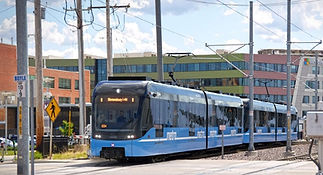AAO Executive Director Stu Nicholson attended the conference and shares his thoughts and observations here.

The annual Midwest Rail Conference brings together freight and passenger rail professionals, consultants, advocates, transportation engineering reps, and government-level transportation officials to discuss both passenger and freight rail issues and projects.
I think largely due to the impacts of the federal Infrastructure and Jobs Act, this session at the Univ. of Toledo drew an especially large crowd of well over 150 attendees. There were several breakout sessions during the day, one each for passenger and freight.
There was virtually no bickering over passenger vs. freight rail. I believe this shows a realization that the benefits of the bi-partisan Infrastructure Act outweigh the negatives of what is a huge, long-term investment through the federal grant process.
The best evidence of the above was a disclosure by both Amtrak and the FRA during the discussion of the much sought-after “South of the Lake (Michigan) Bypass” to alleviate rail congestion in and out of Chicago. It was revealed the Norfolk Southern Railroad has asked for a discussion with Amtrak and the FRA about what can be done to improve capacity in their existing Corridor across Ohio, Indiana, and into Chicago.
The South of the Lake Bypass study is progressing and everyone involved understands this must become a full-fledged project. It is being done in tandem with two projects in Northern Indiana and Chicago known as the Chicago Hub Improvement Project (CHIP) which will also help redirect both commuter and intercity passenger rail traffic in and out of Chicago Union Station. This will have a positive impact on Michigan: helping to enable faster, more frequent service from its three state-supported passenger rail lines.
During a panel of Midwest passenger rail projects the state DOT rail reps from Michigan, Indiana, Illinois and Ohio (ORDC) discussed the following :
Illinois’ Chicago-Springfield-St. Louis passenger rail route is now fully operational at 110-MPH and additions / extensions of its state-supported routes are moving forward.
Indiana is working with the predominant commuter railroad in Northern Indiana to add double track, eliminate grade crossings and general increase the capacity for more service between Chicago and South Bend.
Michigan, as stated above, now has 110-MPH from Detroit to Porter, Indiana and is making upgrades on all of its state-supported routes.
Ohio: ORDC’s Matt Dietrich spoke about CRISI grant freight rail projects with little or nothing said about any of the passenger rail projects being pursued in Ohio.
Matt also stated that the Midwest Interstate Passenger Rail Commission (MIPRC) is “an agency that can bring Midwest DOT’s together on passenger rail. NOTE: Ohio gave up its official membership in the MIPRC in 2010. AAO is trying to push the State to rejoin.
Federal Railroad Administrator Amit Bose’s keynote speech:
Bose said decisions on Ohio’s Corridor ID grant requests should announced “within the next month”.
He said “collaboration with the freight railroads is critical” on what he described as a “pipeline of projects under the Corridor ID program.
He spoke at length about the Long Distance Passenger Rail Corridor program and the Midwest Interstate Rail Compact, which he called a “blueprint” for the much-needed expansion of passenger rail.
It should also be noted that both FRA and Amtrak officials frequently mentioned the existing and planned corridors in Ohio (both long distance and Corridor ID applicants) during the large conference sessions and breakout groups.
Bose got applause when he declared “Now is our time.”
Other Breakout sessions:
Passenger Rail Equipment Fleet for the Midwest: Amtrak is in contract for 88 new “venture” cars for Midwest service along with new “Charger” locomotives. As of the conference, 62 Venture cars are in service and 33 new locomotives.
There is a 7-year timeline by Amtrak to add even more new equipment, according to Joe Schacter of Amtrak.
MIPRC Director Laura Kliewer disclosed some overall economic impacts of improved Midwest Amtrak service:
Overall economic benefit is over $23-billion
Permanent new jobs: 57,450
Construction: estimated 15,000 jobs
Spoke about Invest Midwest: a program to focus over $5 million FRA grant to refine corridor priorities in the region
Important: Kliewer emphasized that Midwest states need to ID funds and funding sources to support operating costs and provide matches for future FRA environmental/engineering and service development grants.
This is a clear message to us that we need to identify and push for a long-term, sustainable source of funding in Ohio for passenger rail & transit projects.
ABOUT ALL ABOARD OHIO
All Aboard Ohio is a non-profit, member-based organization dedicated to promoting improved public transportation and passenger rail service throughout the state.
Founded in 1973 and incorporated as a registered 501c-3 in 1987, All Aboard Ohio has spent more than 50 years advocating, educating, and working towards our goal of a connected Midwest
All Aboard Ohio is a 501c-3 nonprofit with over 50 years of advocacy work, advocating for improved public transportation and passenger rail service in the Midwest
©2025 by All Aboard Ohio
Get in Touch
3136 Kingsdale Center,
#112 Columbus, OH 43221
Federal Tax ID: 31-1066182









